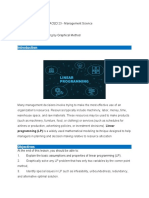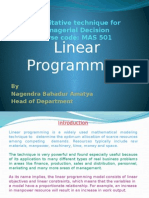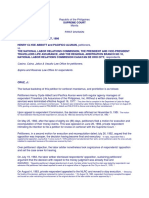Linear Programming Is: (P Ax+by) (C Ax+by)
Uploaded by
I really DUNNOLinear Programming Is: (P Ax+by) (C Ax+by)
Uploaded by
I really DUNNOIntroduction
Linear programming is used for obtaining the most optimal solution for a problem with given
constraints. In linear programming, we formulate our real-life problem into a mathematical
model. It involves an objective function, linear inequalities with subject to constraints.
Many mathematical models designed to solve real world problems in business and economics
involve finding either the maximum or the minimum value of a function, subject to certain
limitations. As a matter of fact, these problems arise in the cases where available to resources
are limited or cannot be fully utilized. In this module, the primary concern is on solving a
particular real-world problem by setting up its corresponding mathematical model. It will be
focus on maximization problems. You identify the parts on how to solve linear programming,
graph maximization problems and give decision rule.
Linear Programming is a method of dealing with decision problems that can be expressed as
constrained linear models. It will help managers to ideally develop a production schedule and an
inventory policy that will satisfy sales demand in the future period at the same time minimize the
total production and inventory costs.
Two Properties of Linear Programming Problems
1. Maximizing ( P=ax+ by)
2. Minimizing (C=ax +by )
3. The function to be optimized in linear programming is called the objective function. This usually
refers to profit maximization or cost minimization. In linear programming problems, constraints are
given by inequalities (called inequality constraints).
4.
5. There are two types of constraints:
6. Structural Constraint is a limit on the availability of resources; it is also referred as explicit
constraint. Non-negativity constraint is the constraint that restricts all the variables to zero
and positive solution; it also referred as implicit constraint. Let’s take the linear
programming model below.
Maximize : P=1200 x +1600 y Objective Function
Explicit Contraints ¿ ⋯ ¿ x ≥ 0 , y ≥ 0 ¿ Implicit Constraints ¿
¿ : ¿
Solving linear programming: Maximization problem.
Example. A firm manufactures 2 products, A and B. Each product is processed by 2 machines,
M 1 and M 2. Each unit of type A requires 1 hour of processing by M 1 and 2 hours in M 2 and
each unit of type B requires 3 hours on M 1 and 1 hour on M 2. The profit on product A is ₱20 per
unit and on product B is ₱30 per unit. If M 1 is available for 200 hours each month and M 2 for
300 hours, how many units of each type can be manufactured in one month in order to
maximize the profits?
Solution:
Step 1. Create a summary table (if necessary).
Let x be the product A and y be the product B. Make a contingency table if necessary.
Product Machine 1 Machine 2 Profit
x → 1x → 2x → 20x
y → 3y → 1y → 30y
Availability 200 hours 300 hours
Step 2. Set-up the functions: (objective, explicit and implicit)
Maximize: P=20 x +30 y
Subject to: x +3 y ≤ 200 hours time in Machine 1
2 x+ y ≤ 300 hours in Machine 2
x, y≥0
Step 3. Solve for feasible vertices algebraically or graphically using the equality
functions above.
a) x +3 y=200 Let x = 0, y = 66.67 (0, 66.67) let y = 0, x = 200 (200, 0)
2 x+ y =300 Let x = 0, y = 300 (0, 300) let y = 0, x = 150 (150,
0)
(Choose the once closest to graphs origin since there are no other explicit
constraints given.)
*selection varies depending on the functions
b) Point of intersection of x +3 y ≤ 200 and 2 x+ y ≤ 300 ,
2 x+ y=300
2 x+ y=300 2 x + y=300 −2 x−6 y=−400
x +3 y=200 −2(x +3 y=200) −5 y=−100
y=20
Solve for x: x +3 y=200 x+ 3 ( 20 )=200 x=200−60 x=140 (140, 20)
Thus, the feasible vertices are (0, 66.67), (150,0) and (140, 20).
(Or use graph to locate the feasible vertices easily, you may use
https://www.desmos.com/calculator )
Step 4: Substitute the feasible vertices to the function to get the maximum
Maximize: P=20 x +30 y
20 ( 0 ) +30 ( 66.67 ) =₱ 2 , 000.10
20 ( 150 ) +30 ( 0 )=₱ 3 , 000.00
20 ( 140 ) +30 ( 20 )=₱ 3 , 400.00
Step 5. Decision
Therefore, there are x = 140 units of product A and y = 20 units of product B.
Maximum profit of P3, 400.00
Assignment:
A local boutique produced two designs of gowns A and B and has the following materials
available: 18 square meters of cotton, and 20 square meters of silk, and 5 square meters of
wool. Design A requires the following: 3 square meters of cotton, 2 square meters of silk and 1
square meter of wool. Design B requires the following: 2 square meters of cotton, 4 square
meters of silk. If the Design A sells for ₱1,200 and Design B for ₱1,600, how many of each
garment should the boutique produce to obtain the maximum amount of money?
You might also like
- Proposals That Work A Guide For Planning Dissertations and Grant Proposals by Lawrence F. Locke, Waneen W. Spirduso, Stephen J. SilvermanNo ratings yetProposals That Work A Guide For Planning Dissertations and Grant Proposals by Lawrence F. Locke, Waneen W. Spirduso, Stephen J. Silverman144 pages
- Module 3: Linear Programming: Graphical Method: Learning OutcomesNo ratings yetModule 3: Linear Programming: Graphical Method: Learning Outcomes9 pages
- 4_Module 4_Unit 3_Linear Programming Models_2037274932No ratings yet4_Module 4_Unit 3_Linear Programming Models_203727493232 pages
- DAM HO PTMBA LPP Graphical With SolutionsNo ratings yetDAM HO PTMBA LPP Graphical With Solutions24 pages
- Mathematics in The Modern World - Finals - ReviewerNo ratings yetMathematics in The Modern World - Finals - Reviewer19 pages
- 3.2a. Solving Linear Programming Problems Graphically Finite MathNo ratings yet3.2a. Solving Linear Programming Problems Graphically Finite Math30 pages
- Linear Programming: A Geometric Approach: 5.1 Chapter OverviewNo ratings yetLinear Programming: A Geometric Approach: 5.1 Chapter Overview7 pages
- Linear Programming Problems 2 SolutionsNo ratings yetLinear Programming Problems 2 Solutions19 pages
- Steampunk a Retrofuturistic 19th Century Aesthetic Workshop XLNo ratings yetSteampunk a Retrofuturistic 19th Century Aesthetic Workshop XL32 pages
- Linearprogramming Problems With SolutionNo ratings yetLinearprogramming Problems With Solution8 pages
- Mekelle University College of Business and Economics Department of ManagementNo ratings yetMekelle University College of Business and Economics Department of Management29 pages
- Linear Programming: Model Formulation and Graphical SolutionNo ratings yetLinear Programming: Model Formulation and Graphical Solution65 pages
- Linear Programming - Graphical Method 07.09.2022No ratings yetLinear Programming - Graphical Method 07.09.20225 pages
- An Introduction To Linear Programming: Instructor: Dr. Mohamed MostafaNo ratings yetAn Introduction To Linear Programming: Instructor: Dr. Mohamed Mostafa46 pages
- MMW Module 5.2 - Linear Programming & APPLICATIONSNo ratings yetMMW Module 5.2 - Linear Programming & APPLICATIONS6 pages
- A Brief Introduction to MATLAB: Taken From the Book "MATLAB for Beginners: A Gentle Approach"From EverandA Brief Introduction to MATLAB: Taken From the Book "MATLAB for Beginners: A Gentle Approach"2.5/5 (2)
- Fall Semester 2020-21 AI With Python ECE-4031No ratings yetFall Semester 2020-21 AI With Python ECE-40315 pages
- Combatting Extreme Absenteeism of Grade 11 TVL Learners Using Strategic Task-Based Affirmative Reinforcements (Star) Technique in Practical Research 1 ClassroomNo ratings yetCombatting Extreme Absenteeism of Grade 11 TVL Learners Using Strategic Task-Based Affirmative Reinforcements (Star) Technique in Practical Research 1 Classroom11 pages
- Model Answer For Question 2 of The IGCSE English Language Paper100% (1)Model Answer For Question 2 of The IGCSE English Language Paper1 page
- Reflection Paper - Ansay, Allyson Charissa BSA - 1 Alfonso100% (2)Reflection Paper - Ansay, Allyson Charissa BSA - 1 Alfonso2 pages
- Plan Lector 2024 Ies M.ariano Melgar - UnocollaNo ratings yetPlan Lector 2024 Ies M.ariano Melgar - Unocolla15 pages
- Visual Organizer Mind Map of Living BeingsNo ratings yetVisual Organizer Mind Map of Living Beings1 page
- Grob Et Al-2019-Journal of Applied Behavior AnalysisNo ratings yetGrob Et Al-2019-Journal of Applied Behavior Analysis23 pages
- (Quiz) History - Free Online Test (10th STD) Chap-11 - TNPSC Guru - TNPSC Todays Latest News TNPSC Vao Result Group 4 - TNPSC100% (1)(Quiz) History - Free Online Test (10th STD) Chap-11 - TNPSC Guru - TNPSC Todays Latest News TNPSC Vao Result Group 4 - TNPSC4 pages
- Places of the Soul Architecture and Environmental Design as a Healing Art 2nd Edition Christopher Day - Download the full ebook now for a seamless reading experience100% (1)Places of the Soul Architecture and Environmental Design as a Healing Art 2nd Edition Christopher Day - Download the full ebook now for a seamless reading experience71 pages
- Chapter 2 Introduction To Technical Writing 1No ratings yetChapter 2 Introduction To Technical Writing 116 pages
- Pec 2 Declaration of Sentiments Seneca Falls 1848 Maximum Grade 22No ratings yetPec 2 Declaration of Sentiments Seneca Falls 1848 Maximum Grade 226 pages

























































































